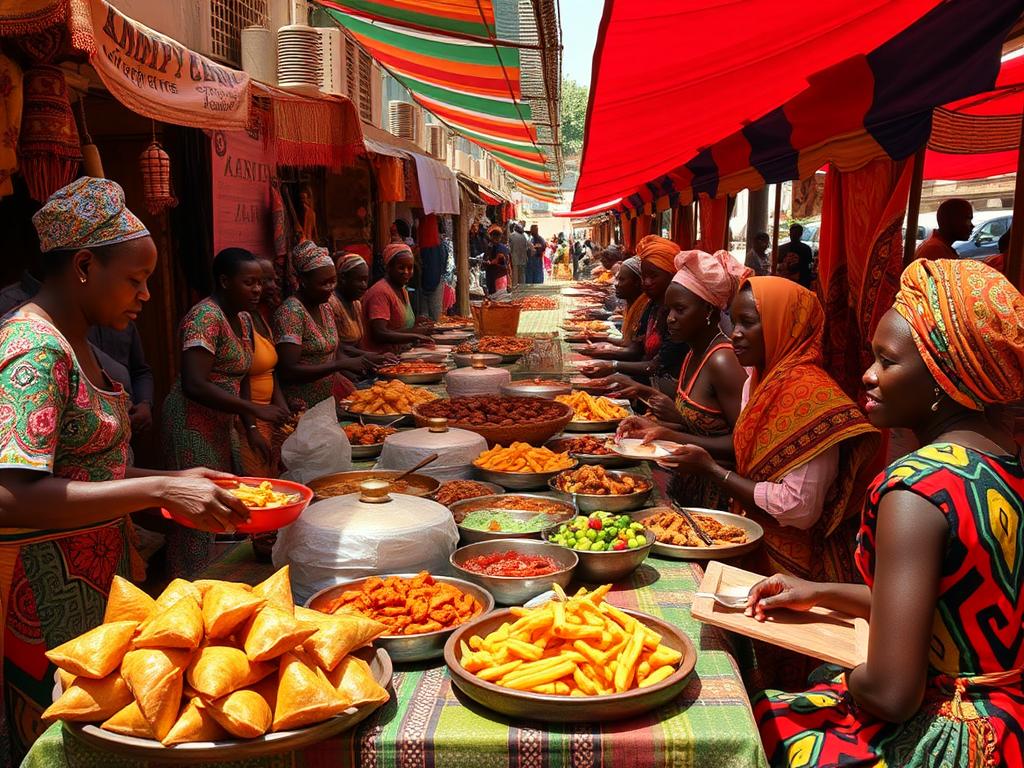
Recipes for Kenyan Snacks: Taste the Richness of Kenya’s Culinary Heritage
Recipes for Kenyan Snacks: Taste the Richness of Kenya’s Culinary Heritage
Introduction
Recipes for Kenyan snacks showcase the incredible diversity and rich flavors embedded in Kenya’s culinary tradition.
From the coastal delicacies influenced by maritime cultures to the hearty dishes from the highlands, each snack tells a story of its origin.
If you’re on a quest to discover flavorful Kenyan snacks, you’re in for a delightful journey.
This article presents a comprehensive list of 50 authentic Kenyan snack recipes, offers preparation tips, cultural backgrounds, and highlights the essential ingredients that make these snacks irresistible.
The Culinary Landscape of Kenya
The culinary scene in Kenya is a reflection of its diverse ethnic communities, geographic landscapes, and historical influences.
Kenyan cuisine is characterized by its use of fresh ingredients, bold spices, and rich flavors.
With major influences from Indian, Arab, African, and colonial British cuisines, snacks in Kenya range from spicy street food to sophisticated starters.
For instance, the ever-popular samosas have origins tracing back to Indian cuisine, while dishes like Nyama Choma have a unique African touch.
Exploring 50 Delicious Kenyan Snacks
Here’s a curated list of 50 must-try Kenyan snacks that represent the vibrancy of this region’s culinary culture.
- Samosas – Crispy pastries filled with spiced meat or vegetables, perfect for any occasion.
- Pilipili Pende – A spicy, savory waffle made with a mix of corn and rice flour, typically served with sauces.
- Kachori – Deep-fried dough filled with a spiced mixture of lentils or peas, often enjoyed with achaar (pickle).
- Mandazi – Sweet, fried doughnuts flavored with coconut and cardamom, perfect for tea time.
- Chips Masala – French fries tossed with a spicy tomato sauce, delivering a burst of flavor in every bite.
- Pork Nyama Choma – Grilled pork skewers marinated in a blend of spices, frequently served with kachumbari (salsa).
- Githeri – A nutritious mix of boiled maize and beans, this dish can be enjoyed hot or cold.
- Bhajias – Potato slices dipped in batter and deep-fried, typically enjoyed with mint or chili sauce.
- Mukimo – A mash made from potatoes and green vegetables like pumpkin leaves, hearty and nutritious.
- Kibanda Chipotle – A spicy version of the classic Chips, garnished with fresh coriander and chili flakes.
- Maandazi – Larger and less sweet than Mandazi, perfect for scooping up sauces.
- Sukuma Wiki – Sautéed kale mixed with onions and tomatoes, great side snack paired with ugali.
- Omena – Small dried fish cooked with tomatoes and onions, often served with ugali.
- Nyama Choma – Grilled meat, a national favorite, typically paired with ugali.
- Burgers – Kenyan-style burgers using lamb or beef, topped with spices and fresh vegetables.
- Fried Plantain – Sweet plantains sliced and fried to perfection, often sprinkled with salt.
- DFR (Deep Fried Roasted Groundnuts) – Crunchy snack made from peanuts roasted and deep-fried.
- Kalio – Spicy lentil stew enjoyed as a filling snack for bread.
- Kowenda – Millet porridge enjoyed as a breakfast snack.
- Chapati – Flaky flatbreads with various accompaniments.
- Kano Chai – Kenyan spiced tea often served with mandazi or fresh chapati.
- Coconut Candy – Sweet treats made from grated coconut and sugar.
- Rice Balls – Made from rice, these snacks can be seasoned or stuffed.
- Kiboko – A dried beef type that can be transported easily, marinated in local spices.
- Pigeon Peas Pockets – Fried dough pockets stuffed with seasoned pigeon peas.
- Sweet Potato Chips – Thinly sliced sweet potatoes fried to crispy perfection.
- Pumpkin Fritters – Sweet, deep-fried fritters flavored with pumpkin.
- Dabo Kolo – Fried lentil balls seasoned with spices.
- Beef Skewers – Grilled marinated beef served on sticks, seasoned perfectly.
- Chege – Fried snacks made from maize flour and boiled lentils.
- Savory Porridge – Breakfast or snack infused with spices.
- Groundnut Stew – Creamy groundnut and spice dish.
- Palaver Sauce – Nutritious sauce made with spinach, paired with rice or ugali.
- Mahamri – Spiced flatbreads made with coconut milk and deep-fried.
- Roasted Corn – Street-style maize enjoyed with salt.
- Air-Fried Chips – Healthier version of chips spiced with local flavors.
- Fruit Chaat – Seasonal fruits mixed with spices and lemon.
- Savory Crackers – Crunchy crackers enjoyed as a contrast to spicy snacks.
- Fish Fry – Fried whole fish served with a side of spicy sauce.
- Vegetable Bhaji – A variety of vegetables coated in flour and deep-fried till crispy.
- Zucchini Fritters – Fresh fritters made with shredded zucchini and spices.
- Cucumber Raita – Chilled cucumber and yogurt mix that complements spicy snacks.
- Savoury Oatmeal Balls – Seasoned oats and vegetables, perfect for snacking.
- Spice-Roasted Nuts – A mix of nuts roasted with varied spices for a delightful crunch.
- Ginger Cookies – Soft, chewy cookies with a hint of ginger—great with tea.
- Spiced Rice Cakes – Rice cakes flavored with spices and herbs.
- Chapati Rolls – Flatbreads filled with spicy fillings, a tasty snack on the go.
- Red Bean Cake – Sweet cakes made with red beans, often served with coconut.
- Crispy Okra – Sliced okra, coated, and fried to crispy perfection.
- Sweet Sesame Snacks – Sweetened sesame seeds pressed into delightful bars.
These snacks are more than mere treats; they represent a vibrant tapestry of flavors woven from the land’s wealth.
The Cultural Significance of Kenyan Snacks
Kenyan snacks offer a window into the rich cultural heritage and social traditions of the nation.
Food plays a central role in Kenyan society, serving as a medium to bring people together during celebrations, family gatherings, or social events.
Popular dishes like Nyama Choma are often shared among friends, symbolizing camaraderie and community spirit.
Furthermore, snacks often spark conversations around historical influences, with each dish hinting at cultural diffusion from various communities.
“Food is not just fuel; it’s an experience, a way of connecting, and a vehicle of culture.” – Unknown
Common Ingredients Used in Kenyan Snacks
Understanding the basic ingredients common in Kenyan snacks can be helpful in recreating these delicious treats at home.
Here’s a list of common ingredients extracted from our featured recipes:
- Maize: Used in various forms, including flour, for snacks like ugali and githeri.
- Beans: A staple protein source, used in dishes like githeri and snacks.
- Spices: Such as cumin, coriander, and chili contribute flavorful profiles across snacks.
- Fresh Vegetables: Local produce like sukuma wiki (kale) enhances flavor and nutrition.
- Coconut: Incorporating coconut milk and grated coconut for sweetness in various recipes.
Incorporating these ingredients into your cooking will help you achieve the authentic flavor profiles of Kenyan snacks.
Tips and Tricks for Preparing Kenyan Snacks
To prepare authentic Kenyan snacks, consider the following tips for an exceptional culinary experience:
- Quality Ingredients: Use fresh, local ingredients whenever possible to enhance flavor.
- Balancing Flavors: Focus on balancing the sweet, sour, and spicy flavors for depth in dishes.
- Experiment with Spice: Adjust the level of spices based on personal preference, particularly if using chilies.
- Presentation Matters: Traditionally, Kenyan snacks are often beautifully presented; don’t skip the aesthetics.
- Try Regional Variations: Each community has its unique twist; explore different regional variations.
Conclusion
Recipes for Kenyan snacks encapsulate an incredible array of flavors, textures, and cultural stories.
By trying out these 50 different snacks, you’re not just indulging in tasty treats; you’re also participating in a rich culinary tapestry that spans generations.
So roll up your sleeves, gather your ingredients, and start exploring the delightful world of Kenyan snacks.
Whether it’s crispy samosas at a gathering or sweet mandazi for breakfast, these snacks promise an adventure for your taste buds.
FAQ
What are the most popular Kenyan snacks?
Some of the most popular Kenyan snacks include samosas, chips masala, mandazi, and Nyama Choma. Each of these snacks offers a unique flavor experience that highlights Kenyan culinary traditions.
Are Kenyan snacks spicy?
Many Kenyan snacks are indeed spicy, as they commonly incorporate various spices and chilies. However, the level of spiciness can vary widely depending on the recipe and personal preferences.
Can I find Kenyan snacks outside Kenya?
Yes, many Kenyan snacks can be found in specialty stores, African markets, or even made at home using easily accessible ingredients.
What is the best accompaniment for Kenyan snacks?
Kenyan snacks are often accompanied by spicy sauces, dips, or refreshing beverages like Kano Chai or fresh fruit juices. They can also be served with traditional meals.
Are Kenyan snacks suitable for vegetarians?
Many Kenyan snacks can be made vegetarian, including bhajias, vegetable bhaji, and mandazi. It’s essential to choose ingredients accordingly.
How do I store leftover Kenyan snacks?
Leftover Kenyan snacks should be stored in an airtight container in the refrigerator to maintain freshness. Reheat before serving to restore their original texture, if applicable.
Can these snacks be frozen?
Yes, many Kenyan snacks freeze well, such as samosas and beef skewers. Ensure they are securely wrapped before freezing to prevent freezer burn.
How can I make Kenyan snacks healthier?
You can make Kenyan snacks healthier by using whole grain flours, reducing the amount of oil used for frying, and incorporating more vegetables into recipes.
What type of flour is typically used in Kenyan snacks?
Several types of flour are used in Kenyan snacks, including maize flour, whole wheat flour, and rice flour. Each adds a unique texture and flavor to the snacks.
How can I learn more about Kenyan cuisine?
To learn more about Kenyan cuisine, consider engaging cookbooks, online cooking classes, and exploring food blogs that focus on Kenyan recipes and traditions.
Engage with the flavors of Kenyan snacks and share your experiences in the comments below!





